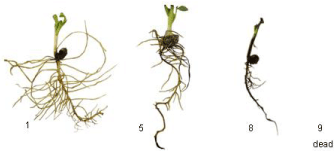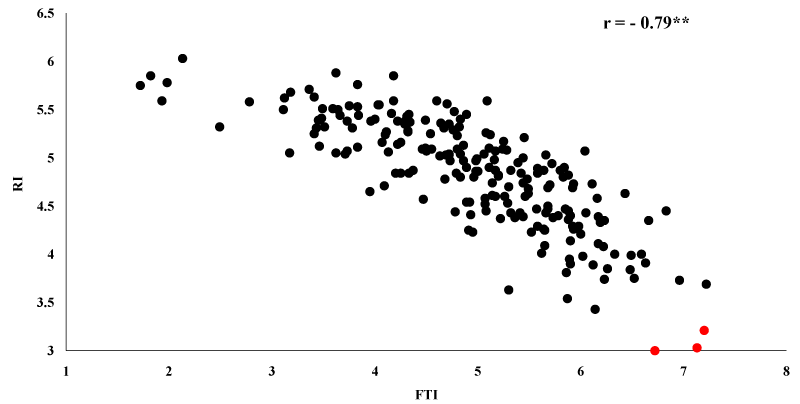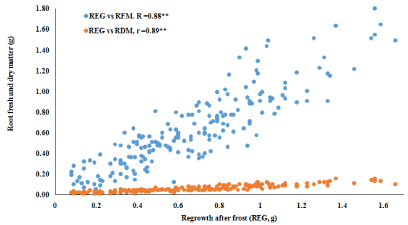Abstract
Frost stress causes a significant damage to winter faba bean yield. Root traits of faba bean seedlings play an important role in resistance to frost tolerance. The main objective was to study the genetic variation in root traits of faba bean seedlings after frost stress. A set of 208 diverse genotypes was tested. The experiments were conducted in a Frost Growth Chamber (FGCh). Root frost susceptibility (RFS), root fresh matter (RFM), and root dry matter (RDM) were scored on all plants after frost stress. A selection index was calculated to improve RFS using RDM and RFM. The results revealed a high genetic variation was found between all genotypes for all traits scored. The repeatability estimates was ranged from 0.52 (RDM) to 0.60 (RFM). Such a high genetic variation and repeatability estimated could be used for selection to improve frost tolerance in winter faba bean through breeding programs.
Keywords: Faba bean, Frost tolerance, Roots, Selection index
Introduction
Faba bean (Viciafaba L.) is one of the most important grain legumes due to its high protein content. The insufficient winter-hardy faba bean genotypes and winter kill in Europe force the spring type of faba bean to be sown [1]. Winter faba bean is higher yielding than spring type [2]. Therefore, breeding for improving frost tolerance in winter faba bean is needed [3]. Frost tolerance can be assessed in field experiments and controlled growth chamber. The advantage of conducting experiments in growth chambers is the ability to test and evaluate seedlings of many genotypes in a short time and thus develop suitable resistant cultivars [4]. Several methods and tools have been developed to study frost tolerance. Examples include visual scoring of freezing injuries in leaves under controlled conditions [5], loss of turgidity and loss of color of both leaves and stems [6]. Most of earlier studies assessed the effect of frost stress on shoots of faba bean [1,6-8]. The effect of the frost stress on roots of faba bean should also be taken into account due to the vital role of roots after exposing the plants to frost stress.
The objectives of this study were
1) to study the genetic variation in roots traits in faba bean seedlings.
2) to create a selection index for root traits in order to select the best frost tolerant genotypes.
Material and Methods
The plant materials consisted of 208 highly homozygous lines from Gottingen Winter Bean Population (GWBP) [9]. When the seedlings of GWBP reached to two expanded leaves, all plants were transferred to a Frost Growth Chamber (FGCh). The genotypes were sown in pots with soil and sand with 3:1, respectively. The experimental layout was alpha lattice design. The genotypes were evaluated in four experiments with two replications each (r = 8). All genotypes were exposed to a hardening phase for 10 days on 5°C, and then subjected to frost treatment three nights at -16°, -18°, and -19°C. The irrigation in the FGCh was applied to the keep the pots at approximately 70% of soil water capacity. The plants were irrigated during hardening phase and stopped when frost test started. After the frost test, the roots of each genotypes were carefully removed from the soil and cleaned with water. Root frost susceptibilit (RFS) was scored using a scale ranging from 1 (no frost symptoms) to 9 (black and dead roots) (Figure 1). Then Root mresh matter (RFM) was weighted for each genotypes. The fresh roots were dried for 48h at 55°C and weighted to estimate Root dry matter (RDM). A selection index was calculated as described in [10]. A root index (RI) was used to better describe RFS (X1) using two auxiliary traits RFM (X2) and RDM (X3) as:

Figure 1: Phenotypic variation in root frost susceptibility after frost test.
RI = b1X1+b2X2+b3X3
Where, b1, b2, and b3 refer to the index coefficients. The vector of Smith-Hazel index coefficient b was estimated as b= P-1 G [11], where P-1 is the inverse of the phenotypic variance-covariance matrix for the traits; G is a matrix including the estimates of genotypic and covariance. The lower values of RI indicate low symptoms of frost. Two additional traits: Frost Tolerance Index (FTI) and Regrowth after Frost (REG) were selected from [12] to study the correlation between roots traits and frost tolerance.
The analysis of variation, repeatability estimates, correlation analyses were performed using PLABSTAT software [13] as follow
Yij = μ + gi+ ej + geij
where Yij is observation of genotype i in experiment j, μ is the general mean; gi, ej are the main effects of genotypes and experiments, respectively; geij is genotype × experiment interaction of genotype i with experiment j. Genotypes were considered as random effects, while, experiments were considered fixed effect.
Results and Discussion
A High genetic variation was found between all genotypes for all roots traits (Table 1). The RI ranged from 3.00 to 6.06 (Figure 2). The repeatability estimates were approximately the same for RDM and RFM (h²~ 0.52). The highest h² accounted for RI (0.62). Such high genetic variation and repeatability estimates could help plant breeder to improve frost tolerance in breeding program by selecting the most promising genotypes showing less symptoms of frost stress. Root frost susceptibility was firstly studied in winter faba bean by [12]. RFS showed high significant correlation with frost tolerant traits in faba bean seedlings. In this study, RFM and RDM were studied as among roots traits due to its role in frost resistance. Roots after frost regulate plant growth and absorb water, minerals, and growth substances. A selection index was created to improve RFS using two auxiliary traits RDM and RFM. Although most of the earlier studies reported the accumulation of dry matter in roots as a response to low temperature, but this may not reflect the growth pattern and other traits should be included to improve tolerance to frost stress [14]. A Selection index provides a powerful tool for distinguishing the tolerant and susceptible genotypes [15]. Therefore, selection based on RI could be very useful to improve frost tolerance rather than single trait selection. A highly significant negative correlation was found between FTI and RI (r = -0.79**) (Figure 3). This offers more support of the role of roots traits in resistance of plants to high frost stress. A Frost tolerance index was calculated from traits scored on shoots of faba bean seedlings [12]. By combining the information from two indices (roots and shoots), promising tolerant genotypes to frost stress can be selected and integrated in breeding programs to improve winter faba bean varieties more tolerant to frost damage. Variation in root fresh matter and dry matter after frost stress reflect the ability of plants to survive after frost test. This is clear from the same high correlation between shoot regrowth after frost and both RFM and RDM (r> 0.88**) (Figure 4).
Trait
Minimum
Maximum
Mean
LSD5%
F-value
h2
RFS
5.11
9.00
7.62
1.35
2.52**
0.60
RDM
0.01
0.16
0.06
0.06
2.10**
0.52
RFM
0.05
1.80
0.61
0.70
2.11**
0.53
RI
3.00
6.03
4.83
0.99
2.60**
0.62
Table 1: Minimum and maximum, LSD, F-value (between genotypes), repeatability estimates (h²) for root traits and root index scored on the 208 winter faba bean genotypes.

Figure 2: Phenotypic variation between genotypes in root selection index.

Figure 3: Correlation between root index (RI) and frost tolerance index (FTI).
Red points refer to the most tolerant genotypes (Less symptoms of frost on
roots and shoots).

Figure 4: Correlation between regrowth after frost (REG) and root fresh
matter (RFM) and root dry matter (RDM). Data of the regrowth after traits was
already published in [9].
Conclusion
In conclusion, frost tolerance should be evaluated on shoots and roots of faba bean plants. Both types of traits provide different information which should be combined to perform improved selections from existing genotypes. This can be achieved through selection index which includes a group of promising traits related to frost tolerance.
Acknowledgment
The authors thank Wolfgang Link, University of Gottingen, for funding this work. This work was done at Division of Plant Breeding, Department of Crop Science, University of Gottingen.
References
- Arbaoui M, Balko C, Link W. Study of faba bean (Vicia faba L.) winterhardiness and development of screening methods. F Crop Res. 2008;106: 60-67.
- Link W, Balko C, Stoddard FL. Winter hardiness in faba bean: Physiology and breeding. F Crop Res. 2010; 115: 287-296.
- Cargeeg LA, Thurling N. Seedling and adult plant resistance to blackleg (Leptosphaeria maculans (Desm.) Ces. et de Not.) in spring rape (Brassica napus L.). Australian Journal of Agri Res. 1980.
- Sallam A. Detailed genetic approach to improve frost tolerance of German winter faba beans. 2014.
- Herzog H. Winter Hardiness in Faba Beans: Varietal Differences and Interrelations among Selection Criteria. Plant Breed. 1988; 101: 269-276.
- Arbaoui M, Link W. Effect of hardening on frost tolerance and fatty acid composition of leaves and stems of a set of faba bean (Vicia faba L.) genotypes. Euphytica. 2007; 162: 211-219.
- Maqbool A, Shafiq S, Lake L. Radiant frost tolerance in pulse crops-a review. Euphytica. 2009; 172: 1-12.
- Picard J, Due G, Pelletier R. Cote d’OR, a highly frost resistant population of Vicia faba. FABIS. 1985; 13: 11-25.
- Gasim S, Abel S, Link W. Extent, variation and breeding impact of natural cross-fertilization in German winter faba beans using hilum colour as marker. Euphytica. 2004; 136: 193-200.
- Falconer D, Mackay T. Introduction to Quantitative Genetics. 4th ed. Prentice Hall: Harlow. 1996.
- Baker RJ. Selection indices in plant breeding. CRC Press. 1986.
- Sallam A, Martsch R, Moursi YS. Genetic variation in morpho-physiological traits associated with frost tolerance in faba bean (Vicia faba L.). Euphytica. 2015; 205: 39-408.
- Utz FH. A computer program for statistical analysis of plant breeding experiments. Institute of Plant Breeding, Seed Science and Population Genetics. University of Hohenheim. 1991.
- Brouwer R. Functional equilibrium: sense or nonsense? Netherlands J Agric Sci. 1983; 31: 335-348.
- Reynolds P, Ortiz-Monasterio J, McNab A, editors. Application of Physiology in Wheat Breeding M Physiology in Wheat Breeding. 2001.
